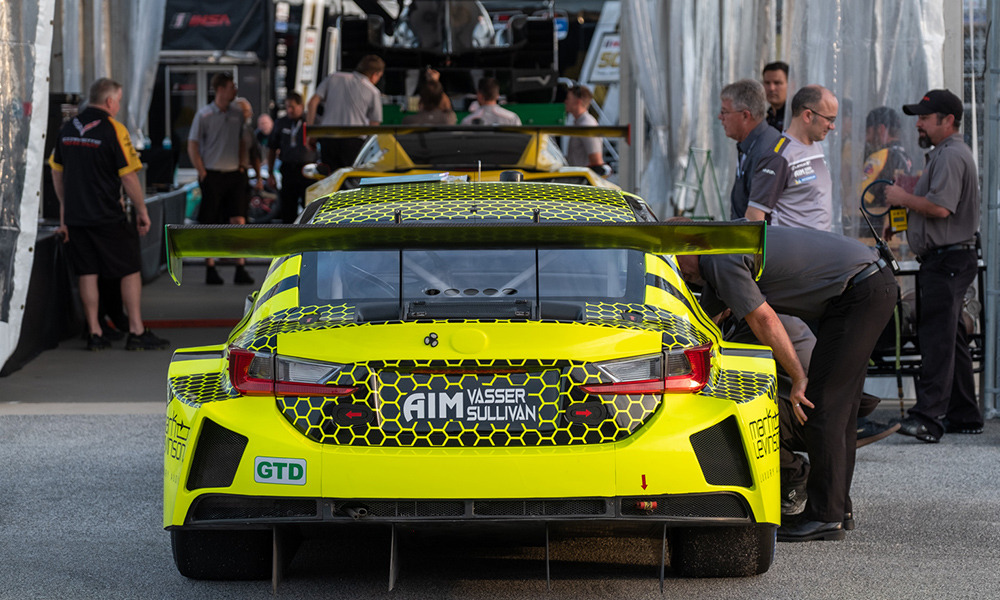
Photo: John Dagys
IMSA has released the starting Balance of Performance for the WeatherTech SportsCar Championship season-opening Rolex 24 at Daytona, while confirming a revised process to the system for 2020.
Issued in a technical bulletin to teams on Friday, the adjustments are relative to last year’s final BoP for Daytona, with the Florida endurance classic remaining with a standalone BoP when compared to the remainder of the season.
According to the sanctioning body, race performance metrics were generated by the best example of each manufacturer’s car in dry conditions in the 2019 season-opener.
Wet weather performance also was analyzed but did not play a role in the 2020 Daytona BoP.
Among the changes in DPi include a 20 kg weight increase for this year’s Rolex 24-winning Cadillac DPi.V-R, although countered with a 0.3 mm larger air restrictor, which is estimated to be a 6 horsepower increase.
Mazda’s RT24-P, meanwhile, gets a 5 kg increase in minimum weight, with no performance-related changes to the championship-winning Acura ARX-05 DPi.
While the initial BoP has been set for both the new Corvette C8.R and Porsche 911 RSR-19 , the Ferrari 488 GTE will get roughly a 5 horsepower increased compared to last year’s race, with the BMW M8 GTE remaining unchanged and now serving as the performance baseline due to the introduction of the two new GTE cars.
The GT Daytona class, meanwhile, sees power reductions across the board, along with minimum weight changes for four of the now-ten eligible cars, as part of an effort by IMSA to widen the performance window between GTLM and GTD.
“The main goal, driven by manufacturer and team feedback, is to address previous top-speed interactions between GTLM and GTD cars,” a statement from IMSA read.
“IMSA expects these reductions will result in even closer competition within each class.
“In addition, the reduction in mass for GTD cars is expected to better align tire degradation over the course of a stint for all cars regardless of mass.”
The changes were “successfully validated” at November’s Michelin IMSA SportsCar Encore at Sebring.
BoP for new or Evo versions of the Aston Martin Vantage GT3, Ferrari 488 GTE Evo 2020 and Mercedes-AMG GT3, meanwhile, have also been established.
More “Human Oversight” Added to BoP Process
After initially being largely data-driven in 2019, IMSA, per the request of manufacturers, has updated its BoP process to allow for more “human oversight”.
It came after collaborative meetings with manufacturers, both the day after the Motul Petit Le Mans as well as a follow-up meeting earlier this month, which led to revised BoP regulations.
“IMSA and our OEM partners share the common goal of providing the most competitive form of sports car racing for IMSA fans,” said IMSA President John Doonan.
“The IMSA Balance of Performance process continues to evolve to ensure the core competitive elements of IMSA sports car racing provide the necessary entertainment and value to our audience and stakeholders.
“The IMSA Technical Committee has worked tirelessly on these modifications for 2020 and it should make for close and competitive racing throughout the season.”
The revised regulation, detailed in the sporting regulations, introduces a new metric aimed at better representing a car’s overall pace during a stint known as the “Weighted Sorted Sector Lap” (WSSL).
The WSSL uses a larger percentage of a car’s demonstrated performance and will be used to compliment the previously used “Weighted Eclectic Lap” (WECL), which mainly focuses around peak performance.
IMSA also will continue to utilize recorded wind tunnel data, engine dyno data and logged car data as a reference to monitor the performance of all cars within each specific class.
Fuel consumption and fuel flow also will continue to be closely monitored to ensure stint-length compatibility, allowing teams to make the difference based on their choices to run full-rich or save fuel during the race.
Starting with the second round at Sebring, the technical committee will analyze data from each 2019 event as generated by the best example of each manufacturer’s car, with a season-long average, excluding Daytona, set to be established.

























